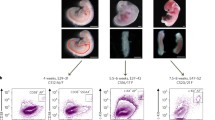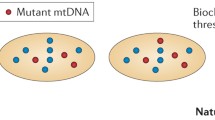Abstract
Mammalian mitochondrial DNA (mtDNA) is inherited principally down the maternal line, but the mechanisms involved are not fully understood. Females harboring a mixture of mutant and wild-type mtDNA (heteroplasmy) transmit a varying proportion of mutant mtDNA to their offspring. In humans with mtDNA disorders, the proportion of mutated mtDNA inherited from the mother correlates with disease severity1,2,3,4. Rapid changes in allele frequency can occur in a single generation5,6. This could be due to a marked reduction in the number of mtDNA molecules being transmitted from mother to offspring (the mitochondrial genetic bottleneck), to the partitioning of mtDNA into homoplasmic segregating units, or to the selection of a group of mtDNA molecules to re-populate the next generation. Here we show that the partitioning of mtDNA molecules into different cells before and after implantation, followed by the segregation of replicating mtDNA between proliferating primordial germ cells, is responsible for the different levels of heteroplasmy seen in the offspring of heteroplasmic female mice.



Similar content being viewed by others
References
Holt, I.J., Miller, D.H. & Harding, A.E. Genetic heterogeneity and mitochondrial DNA heteroplasmy in Leber's hereditary optic neuropathy. J. Med. Genet. 26, 739–743 (1989).
Bolhuis, P.A. et al. Rapid shift on genotype of human mitochondrial DNA in a family with Leber's hereditary optic neuropathy. Biochem. Biophys. Res. Commun. 170, 994–997 (1990).
Vilkki, J., Savontaus, M.L. & Nikoskelainen, E.K. Segregation of mitochondrial genomes in a heteroplasmic lineage with Leber hereditary optic neuroretinopathy. Am. J. Hum. Genet. 47, 95–100 (1990).
Larsson, N.G. et al. Segregation and manifestations of the mtDNA tRNA(Lys) A → G(8344) mutation of myoclonus epilepsy and ragged-red fibers (MERRF) syndrome. Am. J. Hum. Genet. 51, 1201–1212 (1992).
Upholt, W.B. & Dawid, I.B. Mapping of mitochondrial DNA of individual sheep and goats: rapid evolution in the D loop region. Cell 11, 571–583 (1977).
Olivo, P.D., Van de Walle, M.J., Laipis, P.J. & Hauswirth, W.W. Nucleotide sequence evidence for rapid genotypic shifts in the bovine mitochondrial DNA D-loop. Nature 306, 400–402 (1983).
Blok, R.B., Gook, D.A., Thorburn, D.R. & Dahl, H.H. Skewed segregation of the mtDNA nt 8993 (T to G) mutation in human oocytes. Am. J. Hum. Genet. 60, 1495–1501 (1997).
Jenuth, J.P., Peterson, A.C., Fu, K. & Shoubridge, E.A. Random genetic drift in the female germ line explains the rapid segregation of mammalian mitochondrial DNA. Nat. Genet. 14, 146–151 (1996).
Chinnery, P.F. et al. The inheritance of mtDNA heteroplasmy: random drift, selection or both? Trends Genet. 16, 500–505 (2000).
Brown, D.T., Samuels, D.C., Michael, E.M., Turnbull, D.M. & Chinnery, P.F. Random genetic drift determines the level of mutant mitochondrial DNA in human primary oocytes. Am. J. Hum. Genet. 68, 533–536 (2001).
Piko, L. & Taylor, K.D. Amounts of mitochondrial DNA and abundance of some mitochondrial gene transcripts in early mouse embryos. Dev. Biol. 123, 364–374 (1987).
Steuerwald, N. et al. Quantification of mtDNA in single oocytes, polar bodies and subcellular components by real-time rapid cycle fluorescence monitored PCR. Zygote 8, 209–215 (2000).
Larsson, N.G. et al. Mitochondrial transcription factor A is necessary for mtDNA maintenance and embryogenesis in mice. Nat. Genet. 18, 231–236 (1998).
McLaren, A. & Lawson, K.A. How is the mouse germ-cell lineage established? Differentiation 73, 435–437 (2005).
Payer, B. et al. Generation of stella-GFP transgenic mice: a novel tool to study germ cell development. Genesis 44, 75–83 (2006).
Wright, S. Evolution and the Genetics of Populations (University of Chicago Press, Chicago, 1969).
Bendall, K.E., Macaulay, V.A., Baker, J.R. & Sykes, B.C. Heteroplasmic point mutations in the human mtDNA control region. Am. J. Hum. Genet. 59, 1276–1287 (1996).
Poulton, J., Macaulay, V. & Marchington, D.R. Mitochondrial genetics '98: Is the bottleneck cracked? Am. J. Hum. Genet. 62, 752–757 (1998).
Streffer, C., Van Beuningen, D., Mollis, M., Zamboglou, N. & Schultz, S. Kinetics of cell proliferation in the pre-implanted mouse embryo in vivo and in vitro. Cell Tissue Kinet. 13, 135–143 (1980).
Ginsburg, M., Snow, M.H.L. & McLaren, A. Primordial germ cells in the mouse embryo during gastrulation. Development 110, 521–528 (1990).
Tam, P.P.L. & Snow, M.H.L. Proliferation and migration of primordial germ cells during compensatory growth in mouse embryos. J. Embryol. Exp. Morphol. 64, 133–147 (1981).
Downs, K.M. & Davies, T. Staging of gastrulating mouse embryos by morphological landmarks in the dissecting microscope. Development 118, 1255–1266 (1993).
Cao, L. et al. The mitochondrial bottleneck occurs without reduction of mtDNA content in female mouse germ cells. Nat. Genet. 39, 386–390 (2007).
Bergstrom, C.T. & Pritchard, J. Germline bottlenecks and the evolutionary maintenance of mitochondrial genomes. Genetics 149, 2135–2146 (1998).
Spiropoulos, J., Turnbull, D.M. & Chinnery, P.F. Can mitochondrial DNA mutations cause sperm dysfunction? Mol. Hum. Reprod. 8, 719–721 (2002).
Howell, N. et al. Mitochondrial gene segregation in mammals: is the bottleneck always narrow? Hum. Genet. 90, 117–120 (1992).
Hogan, B., Beddington, R., Constantini, F. & Lacy, E. Manipulating the Mouse Embryo (Cold Spring Harbor Laboratory Press, Cold Spring Harbor, New York, USA, 1994).
McGrath, J. & Solter, D. Nuclear transplantation in the mouse embryo by microsurgery and cell fusion. Science 220, 1300–1302 (1983).
Mann, J.R., Gadi, I., Harbison, M.L., Abbondanzo, S.J. & Stewart, C.L. Androgenetic mouse embryonic stem cells are pluripotent and cause skeletal defects in chimeras: implications for genetic imprinting. Cell 62, 251–260 (1990).
Jenuth, J.P., Peterson, A.C. & Shoubridge, E.A. Tissue-specific selection for different mtDNA genotypes in heteroplasmic mice. Nat. Genet. 16, 93–95 (1997).
Acknowledgements
P.F.C. is a Wellcome Trust Senior Fellow in Clinical Science and also receives funding from the United Mitochondrial Diseases Foundation and from the EU FP6 program EUmitocombat and MITOCIRCLE. H.-H.M.D. is a National Health and Medical Research Council (Australia) Principal Research Fellow, and his affiliations are with The Murdoch Children's Research Institute and the Department of Paediatrics (University of Melbourne), Royal Children's Hospital, Melbourne, Australia. We thank I. Dimmick for his assistance with the flow cytometry, D. Turnbull and B. Lightowlers for discussions, A. McLaren for her expertise on the cell dynamics of mouse development, and M. Azim Surani for providing the Stella-GFP mice. We also thank D. Thorburn for discussions and advice while studying the heteroplasmic mice, and both W. Hutchinson and S. White for experimental work on the heteroplasmic mice.
Author information
Authors and Affiliations
Contributions
This laboratory study was designed by P.F.C. and L.M.C. and carried out by L.M.C. The in silico modeling was designed by D.C.S., programmed by H.K.R. and carried out by D.C.S., H.K.R. and P.W. GFP-Stella mice were produced in the laboratory of M. Azim Surani by S.C.d.S.L. H.-H.M.D. designed and supervised the heteroplasmic mouse work. J.R.M. generated the heteroplasmic mice.
Corresponding author
Supplementary information
Supplementary Text and Figures
Supplementary Tables 1 and 2 and Supplementary Figure 1–3 (PDF 262 kb)
Rights and permissions
About this article
Cite this article
Cree, L., Samuels, D., de Sousa Lopes, S. et al. A reduction of mitochondrial DNA molecules during embryogenesis explains the rapid segregation of genotypes. Nat Genet 40, 249–254 (2008). https://doi.org/10.1038/ng.2007.63
Received:
Accepted:
Published:
Issue Date:
DOI: https://doi.org/10.1038/ng.2007.63
- Springer Nature America, Inc.
This article is cited by
-
Mitochondrial DNA quantification correlates with the developmental potential of human euploid blastocysts but not with that of mosaic blastocysts
BMC Pregnancy and Childbirth (2023)
-
Modulating Mitochondrial DNA Heteroplasmy with Mitochondrially Targeted Endonucleases
Annals of Biomedical Engineering (2022)
-
Reduction of mtDNA heteroplasmy in mitochondrial replacement therapy by inducing forced mitophagy
Nature Biomedical Engineering (2022)
-
The mtDNA mutation spectrum in the PolG mutator mouse reveals germline and somatic selection
BMC Genomic Data (2021)
-
Oxygen tension modulates the mitochondrial genetic bottleneck and influences the segregation of a heteroplasmic mtDNA variant in vitro
Communications Biology (2021)





